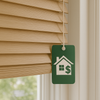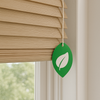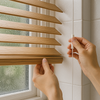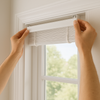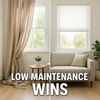Are Motorized Blinds Worth It in 2025? Expert Insights
- by Mariam Labadze
Quick Answer
Motorized blinds are worth the investment in 2025 for homes with hard-to-reach windows, smart home enthusiasts, accessibility needs, or those seeking enhanced security and energy efficiency. Prices have decreased 30-40% since 2020, making quality systems more accessible at £200-£400 per window including installation. Benefits include effortless operation, programmable schedules optimizing energy savings, improved child safety through cordless design, and integration with Alexa, Google Home, and home automation platforms. Battery technology now delivers 6-12 months between charges, whilst solar-powered options eliminate maintenance entirely. The payback period typically spans 3-5 years through energy savings and convenience value, making motorization increasingly sensible for new installations rather than luxury additions.
The Case for Motorized Systems
Unmatched Convenience – The primary benefit of motorization manifests in daily convenience that transforms window treatment interaction. A single button press, voice command, or smartphone tap controls multiple blinds simultaneously, eliminating the need to walk around adjusting individual windows manually. This seamless operation proves particularly valuable during morning routines or when leaving home, allowing instant adjustment of all window treatments without physical effort.
Hard-to-Reach Solutions – Windows above staircases, high ceilings, skylights, or behind furniture present accessibility challenges that motorization solves elegantly. Rather than requiring ladders, reaching over obstacles, or leaving problematic windows perpetually uncovered, motorized systems provide reliable control regardless of physical location. This accessibility alone justifies motorization costs for many homeowners dealing with challenging window placements.
Smart Home Integration – Modern motorized blinds integrate seamlessly with comprehensive smart home ecosystems. Amazon Alexa and Google Assistant enable voice control—"Alexa, close the bedroom blinds"—whilst platforms like Apple HomeKit, Samsung SmartThings, and home automation systems create sophisticated scenes combining window treatments with lighting, climate control, and security systems. This integration transforms isolated window coverings into coordinated elements of intelligent home environments.
Energy Efficiency Automation – Programmable schedules optimize energy performance without daily manual intervention. Set blinds to close automatically during peak summer heat, open during winter mornings capturing solar warmth, and close at dusk retaining heat. This consistent behavior maximizes energy savings that manual operation rarely achieves—humans forget, delay, or can't be bothered adjusting treatments optimally throughout changing conditions.
The Benefits of Modern Automation
Enhanced Security – Motorized blinds operating on schedules create occupied appearances when you're away, deterring potential intruders who target obviously empty homes. Random variation in opening and closing times appears more natural than fixed schedules, suggesting actual occupancy rather than timer-controlled automation. This security enhancement provides peace of mind during holidays or business travel without requiring neighbor intervention.
Child Safety Excellence – Completely cordless motorized systems eliminate strangulation hazards entirely, representing the ultimate child-safe solution. No cords, chains, or wands exist for curious toddlers to access, providing absolute peace of mind for families with young children. This safety benefit alone convinces many parents that motorization justifies its premium pricing.
Accessibility Support – Elderly residents, those with mobility limitations, arthritis, or other physical challenges benefit tremendously from motorized operation. Managing window treatments becomes effortless regardless of manual dexterity or strength limitations, supporting independence and dignity whilst ensuring homes remain comfortable through proper light and temperature control.
Gentle Operation – Motorized systems raise and lower blinds smoothly at controlled speeds, reducing wear on fabrics and mechanisms compared to sometimes jerky manual operation. This gentle movement extends treatment lifespan, delivering better long-term value through reduced replacement frequency offsetting higher initial investment.
Cost Considerations in 2025
Motorized blind costs have decreased substantially as technology matured and production scaled. Quality battery-powered systems now cost £200-£400 per window installed, compared to £400-£600 for equivalent products in 2020. This price reduction makes motorization accessible to mainstream budgets rather than exclusively luxury installations.
Battery-powered motors eliminate electrical requirements, reducing installation costs significantly compared to hardwired alternatives. Modern rechargeable batteries last 6-12 months between charges depending on usage frequency, requiring only periodic USB charging similar to other household electronics. This convenience-to-maintenance ratio proves acceptable for most users.
Solar-powered options exist for windows receiving adequate sunlight, eliminating battery concerns entirely through photovoltaic panels recharging internal batteries continuously. Whilst initial costs exceed battery-powered alternatives by £50-£100 per window, the maintenance-free operation over 10+ year lifespans delivers excellent long-term value.
Compare motorization costs against manual operation challenges. If you're installing new blinds on difficult windows, the £150-£250 motorization premium over standard blinds proves modest relative to years of climbing ladders or leaving windows uncovered. This context makes motorization economically sensible rather than extravagant luxury.
When Motorization Makes Most Sense
New Construction or Renovation – Installing motorization during building or major renovation proves most cost-effective. Electrical access for hardwired systems comes easily, motorized treatments integrate into overall automation planning, and the incremental cost appears modest within larger project budgets.
Multiple Difficult Windows – Homes with several hard-to-reach windows benefit disproportionately from motorization. The per-window cost feels more justified when solving multiple accessibility problems rather than addressing single isolated challenges.
Smart Home Enthusiasts – If you've invested in comprehensive home automation with smart lighting, climate control, and security systems, motorized blinds represent logical extensions of existing infrastructure. The integration value exceeds pure window treatment benefits, contributing to cohesive intelligent home environments.
Specific Rooms – Even with budget constraints, prioritize motorization for bedrooms where convenient bedtime closing and gradual morning opening enhance sleep quality and morning routines. Skylights benefit tremendously from motorization given their inherent inaccessibility.
Technology and Reliability
Modern motorized systems have matured substantially, delivering reliability far exceeding earlier generations that suffered frequent failures and frustrating connectivity problems. Quality manufacturers now offer 3-5 year warranties reflecting confidence in motor longevity and electronic reliability.
Quiet operation represents significant improvement over older motorized blinds. Current quality motors operate at 35-45 decibels—conversational speech volume—avoiding the whirring mechanical sounds that plagued earlier systems and disrupted peaceful environments.
Battery technology advances enable longer runtime between charges whilst smartphone apps often include battery status monitoring, alerting you when recharging becomes necessary before blinds cease operating. This predictive notification prevents the inconvenience of discovering dead batteries when you need blinds functioning.
The Verdict
Motorized blinds in 2025 represent sensible investments for appropriate applications rather than unnecessary luxuries. Decreased costs, improved reliability, enhanced smart home integration, and meaningful convenience benefits justify motorization for many households—particularly those with accessibility challenges, difficult windows, or existing home automation infrastructure.
However, motorization isn't universally necessary. Easily accessible standard windows operated by able-bodied occupants in homes without smart home aspirations may not justify the premium. Assess your specific circumstances, window challenges, and lifestyle priorities determining whether motorization delivers sufficient value justifying its costs.
At 1 Click Blinds, we help UK homeowners evaluate motorization decisions objectively, recommending automated solutions when they genuinely enhance your life whilst suggesting traditional operation where it serves adequately at lower cost. Our goal ensures your investment delivers maximum value matching your needs.

